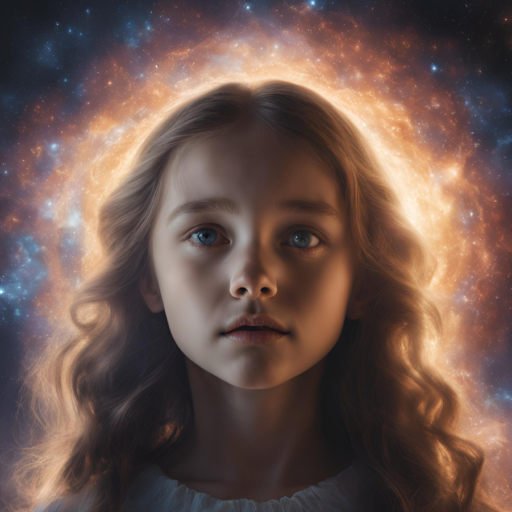Power of Chinnamasta Devi: The Goddess of Life and Death
Chinnamasta Devi: The Self-Decapitating Goddess of Transformation and Self-Sacrifice
The Hindu goddess Chinnamasta Devi stands as one of the most profound and fearsome figures within the Dasha Maha Vidyas, a collection of ten powerful wisdom goddesses in Tantra. Her imagery is both intense and captivating, embodying the ultimate acts of self-sacrifice and spiritual transformation. As the goddess who famously beheaded herself, Chinnamasta Devi symbolizes the transcendence of the ego and the path to enlightenment through radical change. Through the practice of her worship and the sadhanas (spiritual practices) associated with her, devotees are invited to confront their deepest desires, fears, and attachments.
This article will explore the legend of Chinnamasta Devi, her position among the Dasha Maha Vidyas, the tantric practices dedicated to her, and the significance of visiting her temples, such as Chintpurni Temple in Himachal Pradesh. We will also discuss what spiritual seekers can expect from Chinnamasta Devi Sadhana, including transformation and control over desires.
1. The Mythological Background of Chinnamasta Devi
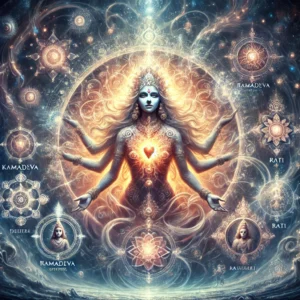
Chinnamasta Devi’s mythological origins are powerful and rich with symbolic meaning. Her story portrays her as the goddess of self-sacrifice, with her image offering lessons about the temporary nature of life and the spiritual rewards of transcending personal ego and desires.
The Myth of Chinnamasta Devi
The popular story of Chinnamasta Devi tells of a moment when the goddess was wandering with her two attendants, Dakini and Varnini when they expressed hunger and asked her for food. In response, Chinnamasta Devi swiftly decapitated herself, and three streams of blood poured out from her neck—one to feed herself and the other two to nourish her companions. This act of self-decapitation was not a gesture of violence but an act of profound compassion and self-giving meant to feed others through her sacrifice.
Chinnamasta Devi’s sacrifice is symbolic of the release of the ego, the self that clings to personal desires and attachments. Through this myth, she conveys the message that true fulfillment comes through selflessness and the dissolution of one’s individual identity.
Symbolism of Decapitation
Chinnamasta Devi’s decapitation is deeply metaphorical. In Hindu and tantric philosophy, the ego is often considered the greatest obstacle to spiritual growth, as it ties individuals to the material world through desires, pride, and attachments. By decapitating herself, Chinnamasta Devi symbolizes the ultimate surrender of ego—a necessary step on the path to spiritual liberation.
The three streams of blood flowing from her body represent the life force (prana) that sustains not only her own existence but also the existence of others. Her form thus highlights the idea of life emerging from death, a crucial theme in her teachings and in the broader tantric tradition.
1.1. Iconography and Symbolism: Blood, Decapitation, and Fertility
Chinnamasta Devi’s visual imagery is one of the most intricate among Hindu deities. Each element of her form carries layers of symbolic meaning, from her posture to the severed head she holds in her hand.
Chinnamasta Devi’s Visual Depiction
Chinnamasta Devi is often shown standing naked, holding her severed head in one hand and a sword in the other. The blood from her neck feeds both her head and her two attendants, signifying the flow of life energy. She stands atop a copulating couple, typically identified as Kamadeva (the god of love) and Rati (the goddess of desire), emphasizing her domination over worldly desires.
Her nakedness symbolizes freedom from illusion (Maya) and from material concerns. In her raw, uncovered form, Chinnamasta Devi represents truth in its most unfiltered state, devoid of societal expectations and the need for self-identity.
The symbolism of Kamadeva and Rati
The couple under her feet, Kamadeva and Rati, represent the forces of passion and lust that fuel human life. By standing on them, Chinnamasta Devi shows her dominance over these forces, teaching that spiritual mastery comes from controlling one’s desires rather than being controlled by them. Her worship encourages the transcendence of these earthly temptations to achieve higher spiritual awareness.
1.2. Chinnamasta Devi and Her Attendants: The Role of Dakini and Varnini
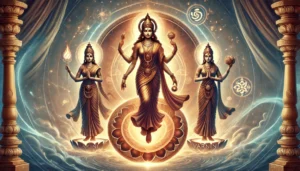
In nearly all representations of Chinnamasta Devi, she is accompanied by two female attendants, Dakini and Varnini, who drink the streams of blood flowing from her neck. These attendants play an essential role in her iconography and carry symbolic meanings of their own.
The Role of Dakini and Varnini
Dakini and Varnini symbolize the dual forces of creation and destruction, life and death, which are central to tantric teachings. By nourishing themselves on the goddess’s blood, they reflect the cycle of existence—everything that lives must also sustain others in the circle of life. Their presence beside Chinnamasta Devi illustrates that her act of sacrifice is not an isolated event but a part of the broader interconnectedness of life.
Chinnamasta Devi’s gift of blood to her attendants also reinforces her teaching that true power comes from giving—that by nourishing others, one finds the path to spiritual fulfillment.
2. Chinnamasta Devi in the Dasha Maha Vidyas: Life, Death, and Transformation
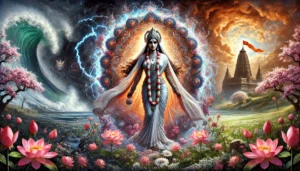
The Dasha Maha Vidyas (Ten Great Wisdom Goddesses) are a group of goddesses who represent different aspects of the divine feminine power (Shakti) and spiritual wisdom. Chinnamasta Devi holds a special place in this group, known for her stark embodiment of the life-death cycle and her role as a goddess of transformation.
Chinnamasta Devi’s Place in the Dasha Maha Vidyas
Among the Dasha Maha Vidyas, Chinnamasta Devi stands apart for her direct confrontation with the ego and her message of radical self-sacrifice. Her unique position emphasizes that destruction is not an end but rather a necessary part of the cycle of creation. Her act of beheading herself represents the ultimate renunciation—giving up one’s ego for the greater good.
Chinnamasta Devi serves as a reminder that in order to experience true spiritual transformation, one must first confront and relinquish the personal self. Her teachings call for devotion and courage, as her worship requires devotees to face their most intense fears and desires.
The Paradox of Life and Death
Chinnamasta Devi’s teachings highlight the dual nature of existence—that life and death are not separate forces but are intertwined. Her form demonstrates this through her ability to sustain life (feeding her attendants) even as she destroys herself. This paradox reflects the deeper tantric understanding that creation and destruction are two sides of the same coin. In order to experience the fullness of life, one must also embrace the reality of death.
2.1. Comparing Chinnamasta Devi with Other Maha Vidyas: Kali, Tara, and Bagalamukhi
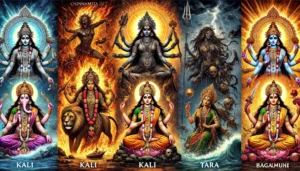
While Chinnamasta Devi is often associated with the fierce aspect of the divine feminine, other goddesses in the Dasha Maha Vidyas also embody transformation and power, including Kali, Tara, and Bagalamukhi. However, each goddess represents these forces in distinct ways.
Kali vs. Chinnamasta Devi
Both Kali and Chinnamasta Devi are fierce goddesses, but their messages differ. Kali is often seen as the destroyer of time and ignorance, with her form representing the inevitable dissolution of all things. In contrast, Chinnamasta Devi represents the destruction of the ego specifically, teaching that personal desires and self-identity must be surrendered for spiritual freedom.
Tara vs. Chinnamasta Devi
While Tara is seen as a compassionate mother who helps devotees navigate through challenges, Chinnamasta takes a more aggressive approach to transformation. Tara is nurturing, whereas Chinnamasta’s fierce actions show that sometimes, spiritual growth requires radical change and fearlessness.
Bagalamukhi vs. Chinnamasta
Bagalamukhi paralyzes the enemies of her devotees, granting power over adversaries, both external and internal. Chinnamasta, on the other hand, focuses on cutting off the ego, the greatest internal enemy. Both goddesses emphasize control, but Chinnamasta’s lessons go deeper, pushing the devotees to surrender their self-identity entirely.
2.2. The Tantric Wisdom of Chinnamasta: Overcoming Fear and Desire
In tantric philosophy, fearlessness is a crucial quality for spiritual aspirants. Chinnamasta embodies this fearlessness, as her self-decapitation shows that even the fear of death can be transcended through spiritual understanding.
Confronting Fears and Desires
Worshipping Chinnamasta forces devotees to confront their fears head-on, particularly their fear of death and loss of identity. In tantric practice, desire is seen as a binding force that keeps individuals trapped in the cycle of birth and rebirth. Chinnamasta’s teachings challenge devotees to overcome their desires and attachments, thereby allowing them to experience
profound spiritual transformation.
The act of decapitation in her iconography represents not only the death of the body but the death of the ego—the source of desires, fears, and attachments that prevent spiritual liberation. Through her worship, practitioners are guided toward the realization that overcoming these powerful forces leads to inner freedom and a deeper connection to the divine.
3. Temples Dedicated to Chinnamasta: Sacred Places for Transformation
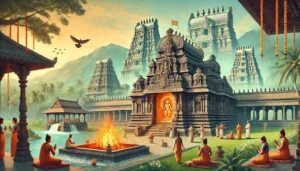
Although Chinnamasta is a relatively lesser-known deity compared to others in the Dasha Maha Vidyas, there are key temples dedicated to her where devotees can perform rituals and seek her blessings. These temples are considered centers of spiritual power, where worshippers go to experience profound inner transformation and connect with the goddess’s fierce, yet liberating energy.
3.1. Chintpurni Temple: A Sacred Shakti Peetha in Himachal Pradesh
The Chintpurni Temple, located in the scenic hills of Himachal Pradesh, is one of the most important shrines dedicated to Chinnamasta. It is part of the network of Shakti Peethas—sacred sites associated with the goddess Shakti, where parts of the body of Sati (Shiva’s consort) are said to have fallen during her cosmic dismemberment. This temple is a highly revered pilgrimage site for those seeking mental peace, spiritual awakening, and the removal of obstacles.
The Spiritual Power of Chintpurni
The name “Chintpurni” translates to “remover of worries”, signifying the temple’s role as a place where devotees come to rid themselves of mental burdens and anxieties. The temple is famous for its ability to relieve stress and clear the mind, allowing devotees to focus on their spiritual goals without the distractions of daily life.
Pilgrims who visit the temple often perform special rituals, offering flowers, food, and sacred items to the goddess in hopes of gaining her blessings for clarity of thought and freedom from life’s troubles. The energy in the temple is considered highly potent, making it a powerful location for engaging in spiritual practices.
Ritual Practices at Chintpurni Temple
Devotees at Chintpurni engage in a variety of tantric rituals, including offerings of red flowers and other sacred symbols representing Chinnamasta’s blood and life force. These rituals are meant to honor the goddess and invoke her blessings, often focusing on the removal of obstacles in personal and professional life. The temple sees heightened activity during the Navaratri festival, a period when the goddess’s energy is believed to be especially powerful.
3.2. Chhinnamastika Temple: A Hub for Tantric Practices in Rajrappa, Jharkhand
Another significant temple dedicated to Chinnamasta is the Chhinnamastika Temple, located in Rajrappa, Jharkhand. This temple is renowned for its association with advanced tantric rituals and is a hub for practitioners seeking the goddess’s transformative power.
The Importance of Chhinnamastika Temple
The Chhinnamastika Temple is known for its intense spiritual energy, making it a vital center for those looking to perform advanced tantric sadhanas (spiritual practices) aimed at invoking Chinnamasta’s transformative powers. The temple’s remote location and rich tantric history make it an ideal site for seeking deep spiritual awakening.
During auspicious times, particularly on new moon nights (Amavasya), advanced tantric practitioners gather at the temple to perform rituals that are believed to awaken and harness Chinnamasta’s powerful energy. These rituals often involve offerings to fire (home), mantra recitations, and meditation on Chinnamasta’s fierce form.
For devotees seeking personal transformation or those who wish to conquer their inner fears and desires, visiting the Chhinnamastika Temple offers a chance to engage with Chinnamasta’s energy in its most direct and powerful form.
4. Chinnamasta Sadhana: The Path to Spiritual Mastery and Transformation
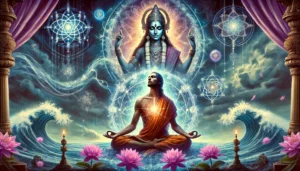
Chinnamasta Sadhana is one of the most intense and transformative spiritual practices in the tantric tradition. Reserved for those committed to achieving spiritual awakening, this practice is designed to bring about a deep internal shift, helping practitioners gain control over their desires and align with higher spiritual principles. It is known for its intensity and for leading to profound spiritual insights when practiced correctly.
The Essence of Chinnamasta Sadhana
Chinnamasta Sadhana involves invoking the goddess through various rituals, mantra recitations, and meditations aimed at awakening one’s inner energy and bringing it into alignment with the goddess’s transformative power. It is not recommended for casual practitioners or those new to tantric practices, as it requires spiritual maturity, discipline, and guidance from a guru.
The goal of the sadhana is to help the practitioner symbolically “cut off” their ego and transcend the limitations imposed by personal desires, fears, and attachments. By connecting deeply with the goddess, the devotee can undergo a radical inner transformation.
4.1. Key Components of Chinnamasta Sadhana
Chinnamasta Sadhana is built on a series of carefully structured rituals and meditations designed to align the practitioner with the fierce yet liberating energy of Chinnamasta.
Mantra Chanting
Mantra recitation is a crucial part of the sadhana. The bija mantra (seed syllable) associated with Chinnamasta is recited repeatedly to invoke her presence. This mantra is believed to stimulate the Kundalini energy at the base of the spine, helping it rise through the chakras (energy centers) to reach a state of spiritual enlightenment.
The mantra recitation is typically done in multiples of 108, often accompanied by an intense meditative focus on Chinnamasta’s form and qualities. The sound vibrations of the mantra are believed to purify the mind, remove obstacles, and open the practitioner to the goddess’s transformative power.
Visualization of Chinnamasta
Meditation on Chinnamasta’s form is another vital aspect of the sadhana. Devotees are asked to visualize the goddess standing in her powerful pose, with her severed head in one hand and blood flowing from her neck. This visualization serves as a reminder to the practitioner of the need to transcend the ego and worldly attachments.
Through consistent visualization and meditation, the practitioner learns to embody the teachings of Chinnamasta—particularly the need for self-sacrifice and ego dissolution to achieve spiritual freedom.
Offerings and Rituals
In the tantric tradition, offerings are a key part of any spiritual practice. During Chinnamasta Sadhana, practitioners make offerings such as red flowers, pomegranate juice, or wine, all of which symbolize the life force (prana) and the blood of the goddess. These offerings are often made in a sacred space in front of a yantra (mystical diagram) or an image of Chinnamasta, accompanied by prayer and mantra chanting.
For advanced practitioners, the sadhana may also involve performing a fire ritual (homa), where offerings are made to the sacred fire, symbolizing the purification and transformation of the soul.
4.2. The Destruction of Ego: The Core of Chinnamasta Sadhana
At the heart of Chinnamasta Sadhana is the concept of ego destruction. In Hindu and tantric traditions, the ego is seen as a barrier to spiritual progress, as it binds individuals to the material world and creates desires and attachments.
Surrendering the Self
By engaging in this sadhana, practitioners symbolically sever their own heads, much like the goddess herself, as a representation of surrendering the ego. This surrender is not easy, as the ego fiercely resists dissolution. However, the sadhana teaches that the ultimate freedom comes from letting go of personal identity and embracing a higher consciousness.
As the sadhana progresses, practitioners report a growing sense of detachment from material concerns and an increasing focus on their spiritual purpose.
4.3. The Spiritual Benefits of Chinnamasta Sadhana
Chinnamasta Sadhana is known for delivering profound results, particularly for those who approach it with full dedication. Some of the primary benefits include:
Kundalini Awakening
One of the main outcomes of Chinnamasta Sadhana is the awakening of Kundalini energy, the dormant spiritual force believed to reside at the base of the spine. Through regular practice, this energy is activated and begins to move upward through the body’s energy centers (chakras), leading to spiritual enlightenment and heightened states of awareness.
Mastery Over Desires
By meditating on Chinnamasta’s posture—standing atop Kamadeva and Rati—devotees learn to master their own desires. Sexual desires, in particular, are seen as one of the strongest attachments to the material world, and the practice of Chinnamasta Sadhana helps individuals rise above these temptations, gaining control over their physical and emotional urges.
Profound Inner Transformation
Chinnamasta Sadhana is not just about spiritual attainment; it brings about a deep internal shift in the practitioner’s perception of life and self. Those who complete the sadhana often experience an awakening that goes beyond everyday awareness, allowing them to see the world from a higher perspective. This transformation often manifests in the form of greater compassion, selflessness, and wisdom.
5. The Importance of Chinnamasta’s Temples in Tantric Worship
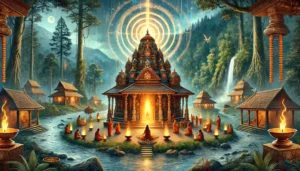
The temples dedicated to Chinnamasta, such as the Chintpurni Temple in Himachal Pradesh and the Chhinnamastika Temple in Jharkhand, are considered powerful spiritual hubs where devotees can perform tantric rituals and seek the goddess’s blessings.
Why Chinnamasta Temples Are Vital for Tantric Practices
These temples are regarded as sacred spaces where tantric rituals can be performed with greater potency. The spiritual energy present at these sites amplifies the power of rituals, allowing devotees to connect more deeply with the goddess and experience profound spiritual transformation.
Many devotees visit these temples with the goal of overcoming personal challenges or seeking guidance in their spiritual journey. The atmosphere at Chinnamasta’s temples is particularly conducive to rituals that require intense focus and dedication.
Pilgrimage to Chintpurni Temple
The Chintpurni Temple is especially popular among pilgrims seeking mental clarity and relief from worldly anxieties. As a Shakti Peetha, it holds immense spiritual significance, and the temple’s energy helps devotees transcend their personal worries, allowing for a greater connection to the divine.
Conclusion: The Transformative Power of Chinnamasta
Chinnamasta, the goddess of transformation and self-sacrifice, offers a powerful path for those seeking to transcend their material attachments and achieve spiritual enlightenment. Her teachings, rituals, and sadhanas invite devotees to confront their deepest fears, desires, and ego, guiding them toward profound inner freedom.
Through practices like Chinnamasta Sadhana and visits to her sacred temples, devotees can experience the life-altering power of her fierce grace, ultimately leading to the mastery of desires and the awakening of Kundalini energy. Those who walk the path of Chinnamasta find themselves forever transformed, moving closer to spiritual liberation.
FAQ: Common Questions About Chinnamasta and Her Worship
- Is Chinnamasta suitable for beginners in tantric practices?
No, Chinnamasta is typically recommended for advanced practitioners due to the intensity of her practices. It is essential to have guidance from a qualified guru before engaging in her worship, as the sadhana involves confronting deep fears and desires.
- What does Chinnamasta’s self-decapitation represent?
Her act of self-decapitation symbolizes the severing of the ego and the renunciation of personal identity and desires. It teaches the importance of surrendering the self to achieve spiritual freedom.
- What are the key benefits of Chinnamasta Sadhana?
The primary benefits include Kundalini awakening, control over desires, and spiritual transformation. Practitioners often experience a deep sense of freedom and enlightenment after completing the sadhana.
- Are there specific times for performing Chinnamasta rituals?
Yes, Chinnamasta rituals are commonly performed during Amavasya (new moon) and other auspicious times like Navaratri, which are ideal for invoking her transformative energy.
- Why are Chinnamasta’s temples important for tantric rituals?
Her temples, such as Chintpurni and Chhinnamastika, are considered powerful energy centers that enhance the effects of tantric rituals. Devotees believe that performing rituals at these sites brings them closer to the goddess and amplifies their spiritual results.


















